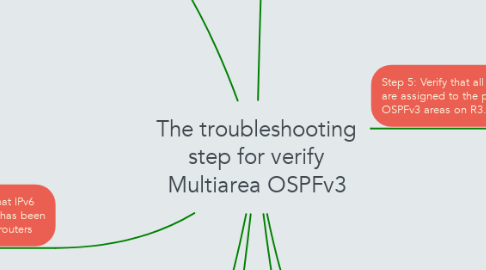The troubleshooting step for verify Multiarea OSPFv3
by Thevendran Paremeswaran

1. Step 3: Verify that all interfaces are assigned to the proper OSPFv3 areas on R1
1.1. . Issue the show ipv6 protocols command to verify that the router ID is correct and the expected interfaces display in their proper areas.
1.2. d Re-issue the show ipv6 protocols command on R1 to make sure changes took effect. d. Enter the show ipv6 route ospf command on R1 to verify that the routes are configured correctly.
1.3. If required, make any necessary changes to the configuration on R1 based on the output from the show ipv6 protocols command. Record the commands used to correct the configuration. It may be necessary to reset OSPF process by issuing the clear ipv6 ospf process command.
2. Step 1: Test IPv6 end-to-end connectivity.
2.1. From each router, ping all interfaces on the other routers. Record your results as IPv6 connectivity problems do exist.
3. Step 2: Verify that IPv6 unicast routing has been enabled on all routers
3.1. An easy way to verify that IPv6 routing has been enabled on a router is to use the show run | section ipv6 unicast command. By adding the pipe section to the show run command, the ipv6 unicast-routing command is displayed if IPv6 routing has been enabled.b. If IPv6 unicast routing is not enabled on one or more routers, enable it now. If required, record the commands used to correct the configuration.
4. Step 7: Verify OSPFv3 routing information.
4.1. Issue the show ipv6 route ospf command, and verify that OSPFv3 routes exist to all networks and Resolve any routing issues that still exist.
5. Step 4: Verify that all interfaces are assigned to the proper OSPFv3 areas on R2.z
5.1. Issue the show ipv6 protocols command and verify that the router ID is correct and that the expected interfaces are showing up under their proper areasce
5.2. If required, make any necessary changes to the configuration on R2 based on the output from the show ipv6 protocols command. Record the commands used to correct the configuration. It may be necessary to reset OSPF process by issuing the clear ipv6 ospf process command.
5.3. Verify that the configuration change has the desired effect.
6. Step 5: Verify that all interfaces are assigned to the proper OSPFv3 areas on R3.
6.1. Issue the show ipv6 protocols command to verify that the router ID is correct and the expected interfaces display under their respective areas.
6.2. If required, make any necessary changes to the configuration on R3 based on the output from the show ipv6 protocols command. Record the commands used to correct the configuration. It may be necessary to reset OSPF process by issuing the clear ipv6 ospf process command.
6.3. . Verify that the configuration changes have the desired effect.
7. Step 6: Verify that all routers have correct neighbor adjacency information.
7.1. Issue the show ipv6 ospf neighbor command to verify that adjacencies have formed between neighboring routers.
8. Step 8: Verify IPv6 end-to-end connectivity.
8.1. From each router, ping all of the IPv6 interfaces on the other routers. If IPv6 end-to-end issues still exist, continue troubleshooting to resolve any remaining issues.


